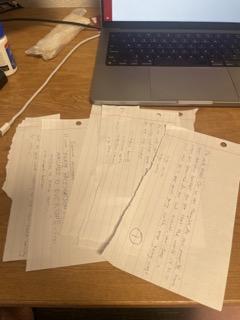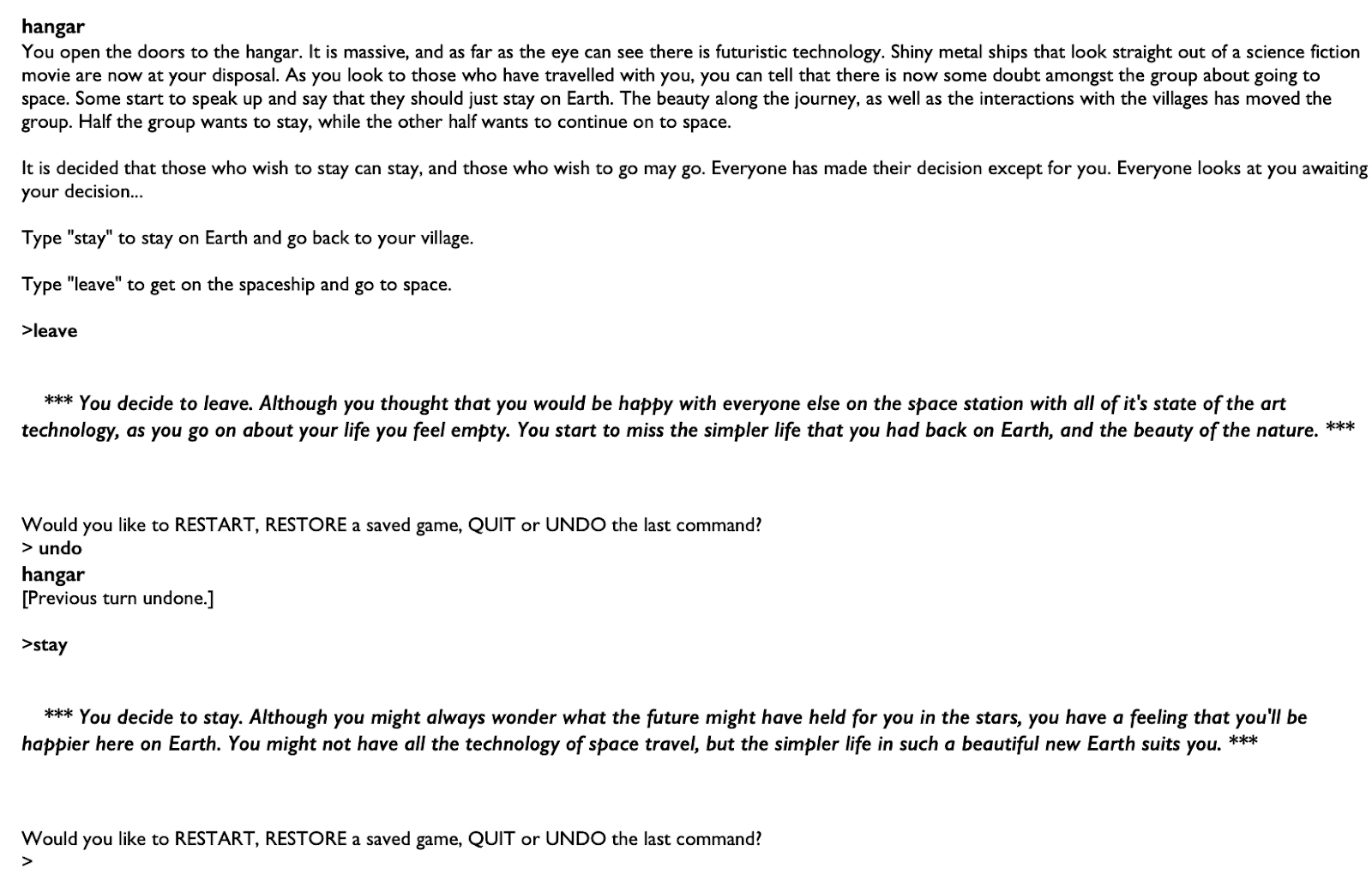Beneath the Stars

Max Murrell
P2: Beneath the Stars
Overview:
The premise of my game is a dystopian Earth, where everyone has fled to a space station to escape the consequences of anthropogenic climate change. Before the space station was ready, a small percentage of people on Earth decided to go into bunkers to survive. After some years in the bunker, you emerge to find an abandoned Earth. After finding other people, you flash forward one year, where you have cultivated a small village with people that you have found. You then hear rumors of ways to contact and or get to the space station, and decide to investigate these rumors. You journey to different villages, finding out what the people know, and also taking in the beauty of different ecosystems on an Earth with almost no people. As you journey and meet these people, you find that they have knowledge of a way to get to the space station, but none of them have gone themselves. At the end of the game, you are forced to decide whether or not you want to go up to space as you originally planned, or if you want to stay on Earth and live the way that you have lived for the past year.
The game is a commentary on appreciating what you have instead of always thinking about how things could be better. When I originally thought of the premise, it was to be a commentary on the consequences and severity of climate change, because I have been learning a lot about this topic in another class that I am taking. After writing more of the story past the initial mapping, the idea of appreciating what you have began to take form more, and felt like a topic that I was a bit more interested in writing about, as I think it appeals to people’s emotions more. I thought that I would be able to evoke more interest and emotion through that topic than something like climate change, where the player might become disinterested.
History Versions of the Game:
Version 1: Tiny Playable Prototype

The first version of my game was a small paper prototype made with flash cards. The player read the card, and chose between 2 or 3 different actions. Depending on their action, I would hand them the corresponding card, and this continued until the game was over. I had only made enough cards to get the introduction to the game done.
Version 2: Small digital prototype

The next iteration of my game was a digital game that was made on Inform. I originally planned on making my game with Twine, and making the story branch out based on the user’s choices. After playing a parser fiction game and thinking more about how I wanted the story to go, I decided to make a parser fiction in Inform. The main reason for this was that I wanted the game to have an exploratory feel to it, but I also wanted to have the story be pretty linear, with one way to get to the end. Again, this prototype was still very short, and only included the introduction. Because of this, the learning objective felt somewhat ambiguous, which will be discussed later on in the playtesting section.
Version 3: Digital prototype with finished story
*Ending of the game pictured below*

The third version of the game was much more complete and fleshed out Inform parser fiction game, with not only the introduction, but also the rough version of the story, all the way from the starting village, to each of the other major plot points, and the ending. Here I added some more mechanics of talking to characters, asking them questions, and added a ‘help’ command to show possible commands for the player when they feel stuck.
Version 4: Final game
The fourth version of my game is my final version. In this version, I didn’t change any of the mechanics or anything in the overall story of the game. I changed some of the descriptions, and how the story was written to reflect the learning objective more, and to make the game more clear to the player based on feedback I got from playtesting version 3.
Playtesting:
- 3 classmates (in class speed dating)
- 2 classmates (in class playtesting)
- 1 friend – 20 year old female Stanford student
- 1 classmate (in class playtesting)
- 1 classmate (in class playtesting)
- 2 friends – 20 year old male Stanford student, 21 year old female Stanford student
Analysis from playtesting
In playtest 1, I tested with 3 of my classmates in class during speed-dating. It was here that I tested the premise of my game with the tiny playable prototype. The most helpful feedback that I got from here was that the premise was interesting, but it needed to be explained to them more since the game was still only an introduction, and the main story had not been introduced during playing.
After iterating and creating my second version, I conducted playtest 2 in class with 2 of my classmates. There was still some confusion about the learning goal since the story was yet to be completed, but the classmates were interested by the mechanics of the parser fiction. It was here that I learned that there was a lot of confusion about possible commands for the player, and since they had not been defined, the playtesters were unsure of what to type into the command line, and required some assistance. Because of this feedback, I added the ‘help’ command, as well as expanded the story for my next iteration.
The next iteration of the game (version 3), was tested in playtest 3-5. I got busy during this version, which is why I kept the same iteration through 2 different classes, however I think it really helped me gain more clarification since this iteration of the game had more content. It was really helpful to test this iteration in class more than once. I gained a lot of feedback from these tests, the most important of which highlighted that I should define my learning objectives earlier on in the story, or at least incorporate them into the descriptions of my game more so that the player begins to learn more about appreciation for what they have. In these playtests, I was able to sit back and watch them play, helping very minimally, as they were able to figure it out with some trial and error and by using the ‘help’ command. I was also considering making a change in mechanics at this stage, because I felt like there was limited actions within the parser fiction, and the user was mainly limited to 1 thing that they could do. Because of this I considered switching to a Twine game where the user clicks commands instead of typing them, however I received feedback in playtest 5 that the parser fiction felt like a good medium. The tester said that although there were only 1 or 2 actions to be done, they felt like since they had to choose what to do and type it themselves, it made them feel more freedom within the game. Because of this, I decided to stick with parser fiction.
In testing the final game, I didn’t receive as much feedback as I did for the previous iteration. While there was still some uncertainty and frustration around the commands, which might be expected in a parser fiction, the playtesters were able to get through the story without assistance. It is also worth noting that in the previous iteration of the game, all playtesters chose to leave Earth, while in the final playtest, both playtesters chose to stay. This shows me that I improved the clarity of the learning objective, as the intention was to have the player stay on Earth, reflecting the idea of appreciation for what you have.
Reflection
If I would have done this again, I would have focused on the breadth of the game rather than the depth. By this, I mean that if I had the same time constraints, I would make the same style of game, but I would have shortened the story and focused on making 1 or two areas the focus of the game with more exploration and more commands available to the player at any given time. Because I tried to make the game with 4 different main areas, I was unable to make the world very explorable due to the time constraints. I would have also tried to refine the writing a little bit more, and tried to change the interface to be a little bit more engaging than just a white background with black text. Overall, I am happy with how the game turned out, and I definitely did not expect this to be the final product when I started, which is largely due to how the playtesting went.
Game link: https://mmurrell.itch.io/beneath-the-stars



